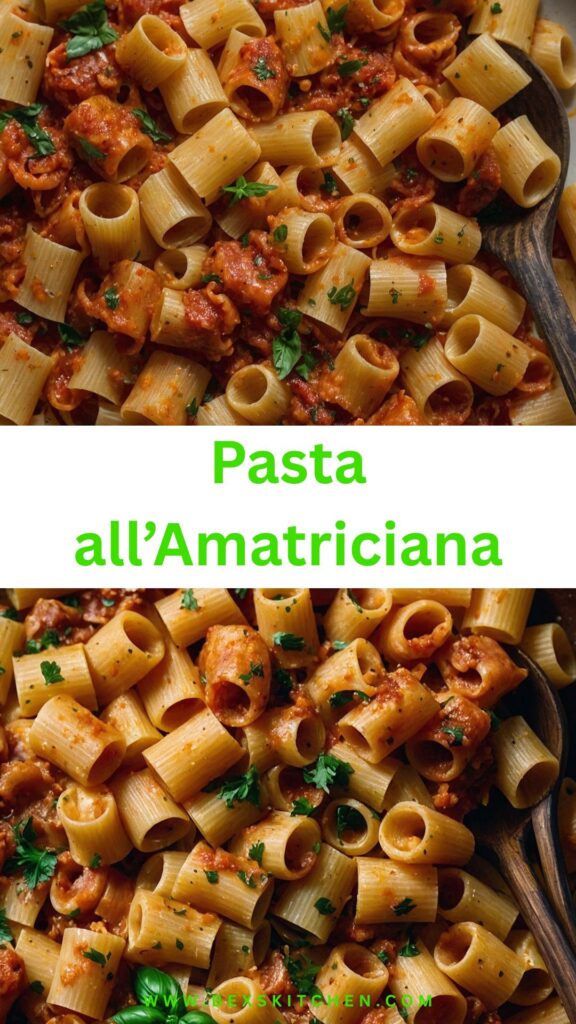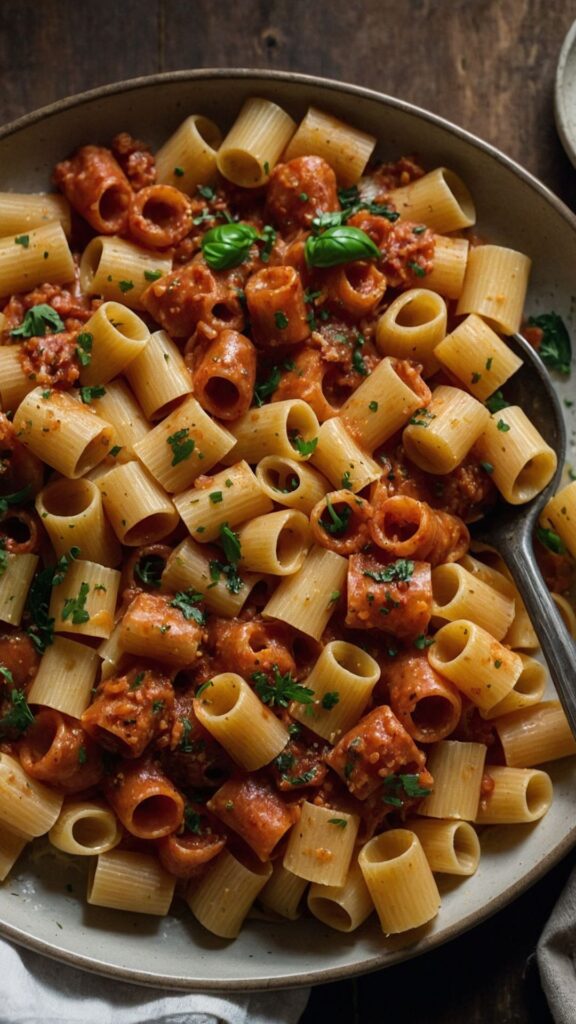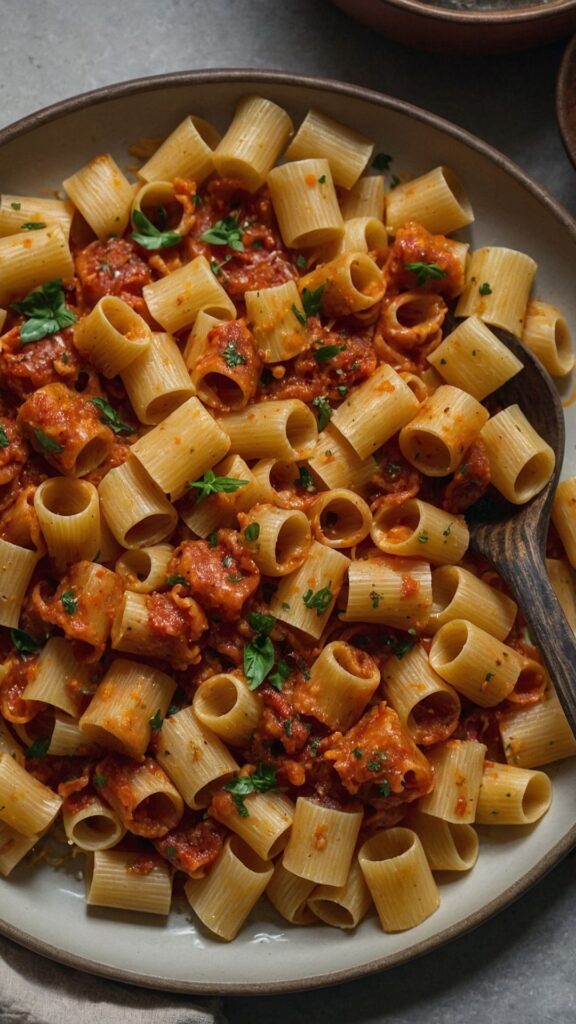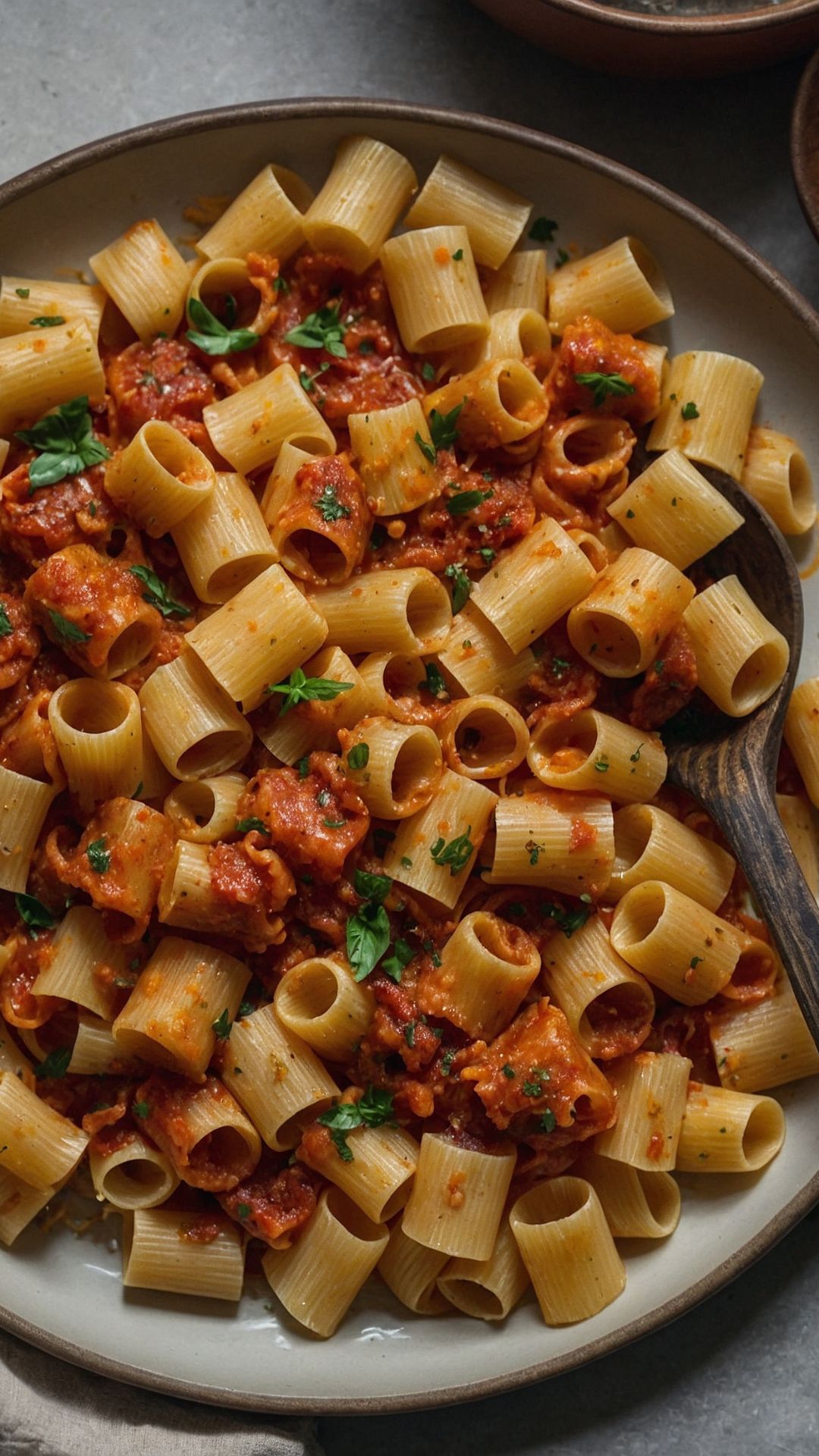Before we dive into the details of Pasta all’Amatriciana, let’s talk about what to enjoy with this dish. Pairing is key to a memorable meal. A glass of a good Italian red wine, such as Chianti or Montepulciano, complements the savory notes beautifully.
A fresh arugula salad with a light lemon vinaigrette acts as a crisp contrast, cutting through the richness of the pasta. For dessert, consider serving a classic Tiramisu or Panna Cotta. These will satisfy your sweet tooth without overwhelming your palate after a hearty main dish.

Gather around, pasta lovers! It’s time to explore the deliciousness of Pasta all’Amatriciana. Originating from the small town of Amatrice in Italy, this dish is a celebration of simple, high-quality ingredients that come together to create something spectacular.
As someone who has experimented with countless pasta recipes, this one holds a special place in my heart (and my belly!). Whether you’re familiar with Italian cuisine or just dipping your toes into it, this dish promises to be a comforting and satisfying experience.
Now, let’s unravel the story of Pasta all’Amatriciana, where the flavors are bold, the aromas irresistible, and the preparation is straightforward. So, roll up your sleeves, and let’s dive into this culinary adventure!
What is Pasta all’Amatriciana?
Pasta all’Amatriciana is a traditional Italian pasta dish made with a few key ingredients: guanciale (cured pork cheek), Pecorino Romano cheese, and San Marzano tomatoes. The base is typically mezzi rigatoni or bucatini, which elegantly holds the sauce, allowing each bite to burst with flavor. Originating from the town of Amatrice, this dish has traveled through time and become a staple in Italian cuisine.
The beauty of dishes like Pasta all’Amatriciana lies in their simplicity. With just a handful of ingredients, you can create something that speaks volumes. Each component adds a unique dimension. Guanciale gives it depth, while Pecorino Romano adds a salty, nutty flavor that evokes the essence of Italy.
What Makes This Recipe Different From Other Pasta all’Amatriciana?
While many versions of all’Amatriciana exist, my approach is rooted in authenticity. I’ve carefully curated these ingredients based on traditional recipes passed down through generations. First off, the use of guanciale is crucial. Unlike pancetta, guanciale is richer and more flavorful, providing a distinct taste you won’t forget. The quality of Pecorino Romano also matters; I always opt for the real deal, aged to perfection, which adds a richness that truly elevates the dish.
Another difference is the cooking technique. Gentle rendering of the guanciale releases its natural oils, creating an aromatic base that forms the foundation of the sauce. Using San Marzano tomatoes, known for their sweet flavor and low acidity, infuses the sauce with a fresh brightness that balances the richness. These subtle choices contribute to a food experience that feels celebratory!
How Does It Taste?
Imagine the comfort of warm pasta enveloped in a rich, smoky tomato sauce that tingles your taste buds. The saltiness of the guanciale dances with the creamy Pecorino Romano, while the tomatoes add just the right amount of acidity. Each bite is an experience that warms the soul. You might even find yourself transported to a quaint Italian trattoria.
You will also like the following Lunch recipes!
Ingredients You’ll Need to Make This Dish
Now that you’re ready to jump in, let’s gather our ingredients. This is where the magic begins.
- 1 pound (~500 grams) dry pasta of choice (mezzi rigatoni recommended)
- 4 ½ ounces (125 grams) guanciale, cut into small strips
- 1 (28-ounce / 794 grams) can San Marzano whole tomatoes, well-drained
- 2 cloves garlic, lightly smashed
- 1 teaspoon extra-virgin olive oil
- ¼ teaspoon red pepper flakes, lightly crushed
- 3 ½ ounces (100 grams) finely grated Pecorino Romano cheese
- ¼ cup (50 mL) crisp dry white wine
- Fine sea salt and freshly ground black pepper, to taste
These ingredients are designed to create a meal that is both hearty and wholesome, appealing to a wide range of palates.

Step-by-Step Instructions
Step 1: Prepare Your Ingredients
Start by gathering everything you need. Chop the guanciale, drain the San Marzano tomatoes, and have your cheese ready to go. Prepping the ingredients ensures a smooth cooking process.
Step 2: Cook the Pasta
In a large pot, bring salted water to a rolling boil. Add the pasta and cook until al dente according to package instructions. Remember, you can always taste-test to find that perfect level of doneness. Strain the pasta but save about 1 cup of the pasta water.
Step 3: Sauté the Guanciale
In a large skillet, heat the olive oil over medium heat. Add the guanciale strips and cook until they’re crispy and golden brown. This should take about 8-10 minutes. The goal is to render the fat and infuse the oil with flavor.
Step 4: Add the Garlic
Once the guanciale is crispy, add the smashed garlic cloves. Make sure to keep an eye on them! You want just enough time for the garlic to infuse its flavor into the oil, but don’t let it burn. After about 1-2 minutes, remove the garlic cloves from the pan.
Step 5: Incorporate the Tomatoes
Now it’s time for the stars of the show—the San Marzano tomatoes! Crush the tomatoes gently using your hands or a fork and add them to the skillet. Stir everything together and bring it to a simmer. Let it cook for about 10 minutes, allowing the flavors to meld.
Step 6: Deglaze With Wine
Pour in the white wine, scraping up any bits stuck to the bottom of the skillet. This adds a layer of complexity. Let the wine reduce by about half.
Step 7: Combine Everything
Add the cooked pasta to the skillet, tossing it with the sauce. If it looks dry, gradually add some reserved pasta water until you reach your desired consistency. Don’t forget to include the crushed red pepper flakes for a hint of spice!
Step 8: Finish With Cheese
Finally, stir in the finely grated Pecorino Romano cheese. The heat from the pasta will help it blend into the sauce and create a creamy texture that’s simply delicious.
Tips & Tricks On Making Pasta all’Amatriciana
Making Pasta all’Amatriciana might seem simple, but these tips will take your dish to the next level:
- Use Quality Ingredients: Opt for authentic Italian guanciale and Pecorino Romano for the best flavor.
- Don’t Skip the Garlic: Even though it may seem optional, garlic deepens the flavor.
- Pasta Water is Key: The reserved pasta water helps the sauce cling to the noodles beautifully.
- Taste as You Go: Adjust seasoning and consistency throughout the cooking process.
- Let it Rest: Allowing the dish to sit for a few minutes can enhance the flavors even further.
Nutrition Information
Wondering about the health aspect? Here’s a rough estimate of nutrition per serving (based on 4 servings):
- Calories: 500
- Protein: 20g
- Carbohydrates: 68g
- Fat: 18g
- Fiber: 2g
It’s a hearty meal that, while undoubtedly rich, is a delightful treat on occasion.

How Do I Store This Dish?
If you’re lucky enough to have leftovers, storing them is easy! Pasta all’Amatriciana keeps well for up to three days when refrigerated in an airtight container. When you’re ready to enjoy it again, simply reheat on the stove with a splash of water or olive oil to bring it back to life.
What Other Substitutes Can You Use in Pasta all’Amatriciana?
In case you don’t have all the ingredients on hand or want a twist, here are some alternatives:
- Pancetta: A good substitute for guanciale, but with a different flavor profile.
- Canned Tomatoes: Any good-quality canned tomatoes will suffice if San Marzano isn’t available.
- Parmesan Cheese: If Pecorino Romano isn’t in your pantry, finely grated Parmesan can work as a substitute.
- Veggie Option: Swap out guanciale for sautéed mushrooms, which provide a different kind of umami.
- Gluten-Free Pasta: For those with dietary restrictions, gluten-free pasta can easily replace traditional pasta.

Equipment
- skillet
Ingredients
- 1 pound ~500 grams dry pasta of choice (mezzi rigatoni recommended)
- 4 ½ ounces 125 grams guanciale, cut into small strips
- 1 28-ounce / 794 grams can San Marzano whole tomatoes, well-drained
- 2 cloves garlic lightly smashed
- 1 teaspoon extra-virgin olive oil
- ¼ teaspoon red pepper flakes lightly crushed
- 3 ½ ounces 100 grams finely grated Pecorino Romano cheese
- ¼ cup 50 mL crisp dry white wine
- Fine sea salt and freshly ground black pepper to taste
Instructions
Step 1: Prepare Your Ingredients
- Start by gathering everything you need. Chop the guanciale, drain the San Marzano tomatoes, and have your cheese ready to go. Prepping the ingredients ensures a smooth cooking process.
Step 2: Cook the Pasta
- In a large pot, bring salted water to a rolling boil. Add the pasta and cook until al dente according to package instructions. Remember, you can always taste-test to find that perfect level of doneness. Strain the pasta but save about 1 cup of the pasta water.
Step 3: Sauté the Guanciale
- In a large skillet, heat the olive oil over medium heat. Add the guanciale strips and cook until they’re crispy and golden brown. This should take about 8-10 minutes. The goal is to render the fat and infuse the oil with flavor.
Step 4: Add the Garlic
- Once the guanciale is crispy, add the smashed garlic cloves. Make sure to keep an eye on them! You want just enough time for the garlic to infuse its flavor into the oil, but don’t let it burn. After about 1-2 minutes, remove the garlic cloves from the pan.
Step 5: Incorporate the Tomatoes
- Now it’s time for the stars of the show—the San Marzano tomatoes! Crush the tomatoes gently using your hands or a fork and add them to the skillet. Stir everything together and bring it to a simmer. Let it cook for about 10 minutes, allowing the flavors to meld.
Step 6: Deglaze With Wine
- Pour in the white wine, scraping up any bits stuck to the bottom of the skillet. This adds a layer of complexity. Let the wine reduce by about half.
Step 7: Combine Everything
- Add the cooked pasta to the skillet, tossing it with the sauce. If it looks dry, gradually add some reserved pasta water until you reach your desired consistency. Don’t forget to include the crushed red pepper flakes for a hint of spice!
Step 8: Finish With Cheese
- Finally, stir in the finely grated Pecorino Romano cheese. The heat from the pasta will help it blend into the sauce and create a creamy texture that’s simply delicious.
Notes
- Use Quality Ingredients: Opt for authentic Italian guanciale and Pecorino Romano for the best flavor.
- Don’t Skip the Garlic: Even though it may seem optional, garlic deepens the flavor.
- Pasta Water is Key: The reserved pasta water helps the sauce cling to the noodles beautifully.
- Taste as You Go: Adjust seasoning and consistency throughout the cooking process.
- Let it Rest: Allowing the dish to sit for a few minutes can enhance the flavors even further.
Nutrition
Frequently Asked Questions
Can I use turkey bacon instead of guanciale?
While turkey bacon can work in a pinch, it won’t provide the same deep, rich flavor. Try to find guanciale or pancetta for the best results.
What’s the best way to prevent the pasta from sticking?
Make sure to stir the pasta immediately after adding it to the boiling water. Additionally, tossing it with a bit of olive oil after cooking will help keep it separate.
Can I make this dish vegetarian?
Absolutely! Substitute the guanciale with sautéed eggplant or mushrooms, and you’ll have a flavorful vegetarian version.
Is it okay to use dried herbs?
While fresh herbs are often preferred, a pinch of dried oregano or basil can add flavor too. Just remember to use them sparingly since dried herbs are more potent.
What if I’m allergic to cheese?
If you need to avoid cheese entirely, you might want to try a nutritional yeast sprinkle instead or simply enjoy the dish without.
Conclusion
Pasta all’Amatriciana is one of those signature dishes that embodies not just a meal, but a sense of comfort and tradition. From the crispy guanciale to the creamy Pecorino Romano, every ingredient plays a role in a beautiful harmony of flavors. By following this guide, I hope you feel empowered to create this dish in your own kitchen, whether it’s for a quiet dinner or a bustling gathering.
This recipe is more than just food; it’s an invitation to enjoy a taste of Italy, right at home. So, gather your loved ones, serve up a plate of this delightful pasta, and indulge in the joyous experience of sharing a meal. Buon Appetito!
